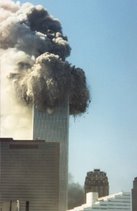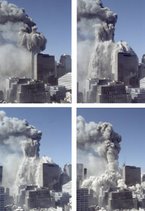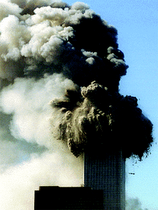Subscribe to:
Post Comments (Atom)
skip to main |
skip to sidebar

The top is already gone - what is pressing down on this massive building?

Stop calling this a "collapse"

Smoke pours up; the building peels to the sides all the way down to the ground.

If the top part is what is pile-driving the bottom part, why is it shorter than the top of the North Tower next to it? If gravity is all that is doing this, doesn't all that dust mean that the lower part is resisting the upper part? How is the top part losing mass at the same time it is driving the lower part downward in "free-fall"? And why didn't the top part fall off to the side? (Part of this may be perspective, but other pictures show the top part losing mass early on).

"As the heat of the fire intensified, the joints on the most severely burned floors gave way, causing the perimeter wall columns to bow outward and the floors above them to fall. The buildings collapsed within ten seconds, hitting bottom with an estimated speed of 200 km/h" MIT Professor Thomas Eager


Those massive core columns could support the building's weight several times over. The external columns could also bear 40% of the building's weight with no wind, and also could withstand steady wind loads of 30 times the weight of a Boeing 767.

Real planes don't do this.
Blog Archive
Faked Videos Broadcast on 9/11
Jeff King on crash physics
The Twin Towers did not collapse; they were pulverized.
North Tower Pulverization

The top is already gone - what is pressing down on this massive building?
South Tower Pulverization

Stop calling this a "collapse"
Blown to Kingdom Come

Smoke pours up; the building peels to the sides all the way down to the ground.
South Tower Obliteration

If the top part is what is pile-driving the bottom part, why is it shorter than the top of the North Tower next to it? If gravity is all that is doing this, doesn't all that dust mean that the lower part is resisting the upper part? How is the top part losing mass at the same time it is driving the lower part downward in "free-fall"? And why didn't the top part fall off to the side? (Part of this may be perspective, but other pictures show the top part losing mass early on).
Do you trust your own judgment? Does this make sense?

"As the heat of the fire intensified, the joints on the most severely burned floors gave way, causing the perimeter wall columns to bow outward and the floors above them to fall. The buildings collapsed within ten seconds, hitting bottom with an estimated speed of 200 km/h" MIT Professor Thomas Eager
Firefighters reach 78th floor of South Tower
Fire Engineering Editor - investigation was "half-baked farce"

Strong Building

Those massive core columns could support the building's weight several times over. The external columns could also bear 40% of the building's weight with no wind, and also could withstand steady wind loads of 30 times the weight of a Boeing 767.
"Flight 175"

Real planes don't do this.

3 comments:
good one, JK's intelligence and background are CRUCIAL for S-11 Truth...
""the only really dense part of the plane are the engines which of course are these great big lumps of titanium and steel""
~narrative taken from vid.
---
they are not really "great big lumps".
a wrecking ball is a "great big lump".
a 767 engine, while being comprised of steel and perhaps titanium, is actually quite brittle and even fragile. there would be a center shaft, which would indeed be quite strong but hardly a great big lump, and some kind of motor to drive this shaft and the brackets which held it all in place but the rest of the engine would be a delicate fan and housing and fuel/air injectors which would shatter into a zillion and one pieces upon impacting against the massive steel columns of a wtc.
i stand by my "767 is nothing more than a flying beer can and would squash against a wtc" analogy.
i see that jenkins has yet to state in what manner would the smooth rounded lightweight plastic/aluminum nosecone/fuselage of a REAL 767 penetrate the massive steel/concrete of a wtc.
would it:
A) cut thru like a blade?
B) bludgeon thru like a hammer?
C) flow thru like a liquid?
these are the true physics of an aluminum/plastic 767 vs. steel/concrete wtc.
i posed this question more than a year ago @ 911blogger.com when i first noticed jim fetzer commenting there. he has not seen fit to discuss this.
indeed, even morgan reynolds has not responded to to the very same question:
"in what manner, sirs? in what manner."
~ha.
Still, I would agree with King that the engines are the most dense part of the plane. If anything were to penetrate, it would be these.
Post a Comment